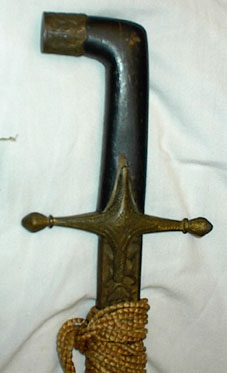Scimitar
(aka Shamshir or Kilij)

This is a very common style saber, normally associated with mounted "horsemen." This example has a shallow curve, but normally, these have a very pronounced
curve; they are very useless as thrusting weapon and are generally accepted as a slashing weapon.
The Persian and Turkish saber versions are referred to as scimitars or kilij, while
the Indian saber versions are referred to as shamshirs.
This example could be from either region as both used a similar "pistol-grip" or "marmeluke" hilt design; however, the blade is more
European is shape so I suspect this is of the Persian or Turkish variety.
The most notable feature - other than the grip - is the crossguard; it is shaped in the form of a cross or 4-pointed star, in which the upward pointing langets extend
into the hilt, the lower langets extend over the throat of the scabbard.
It should be noted that British and US, Navy and Marine Officers used a very
similar sword; additionally, US Militia Infantry Officers used a similar sword
in the early to mid-1800s, but with a straight blade. This hilt style is referred
to as the "marmeluke" style.

